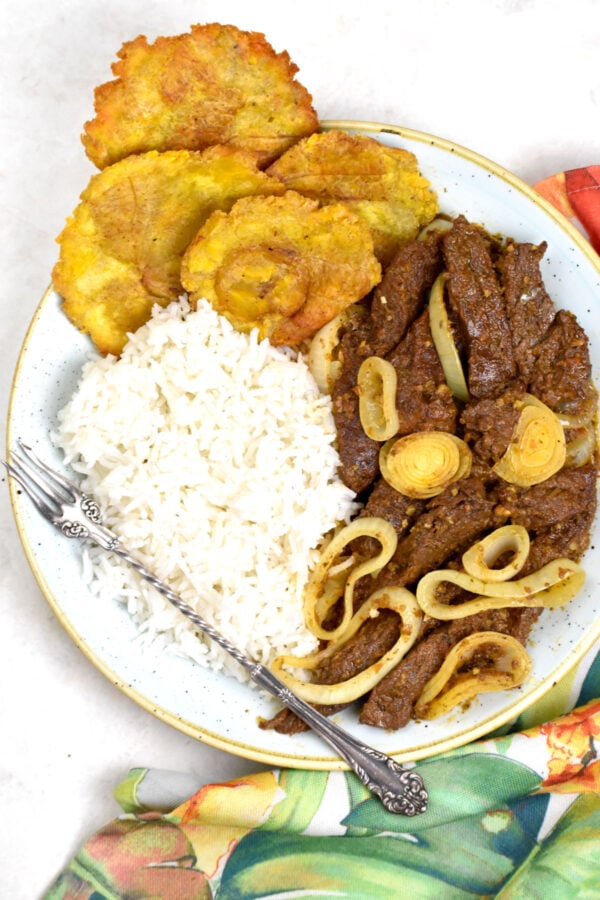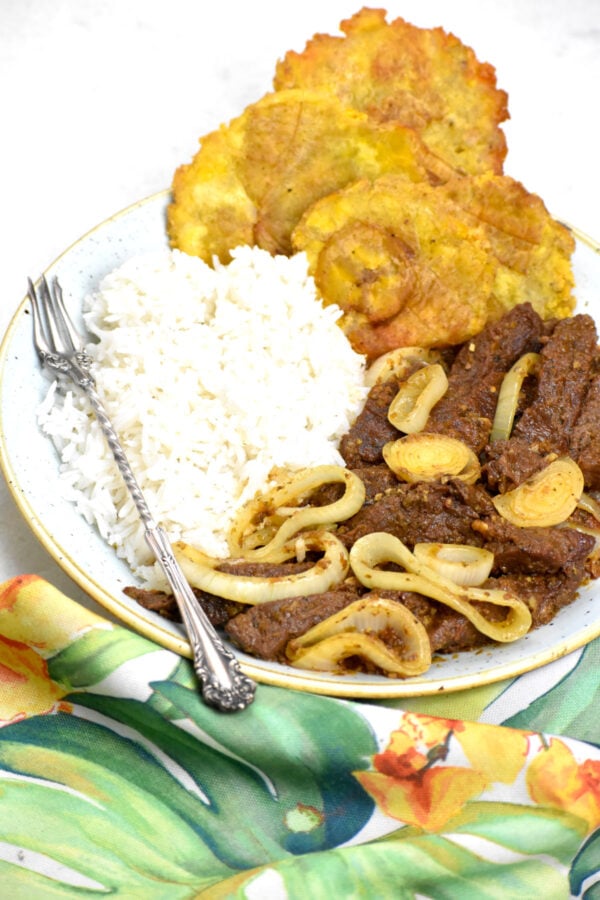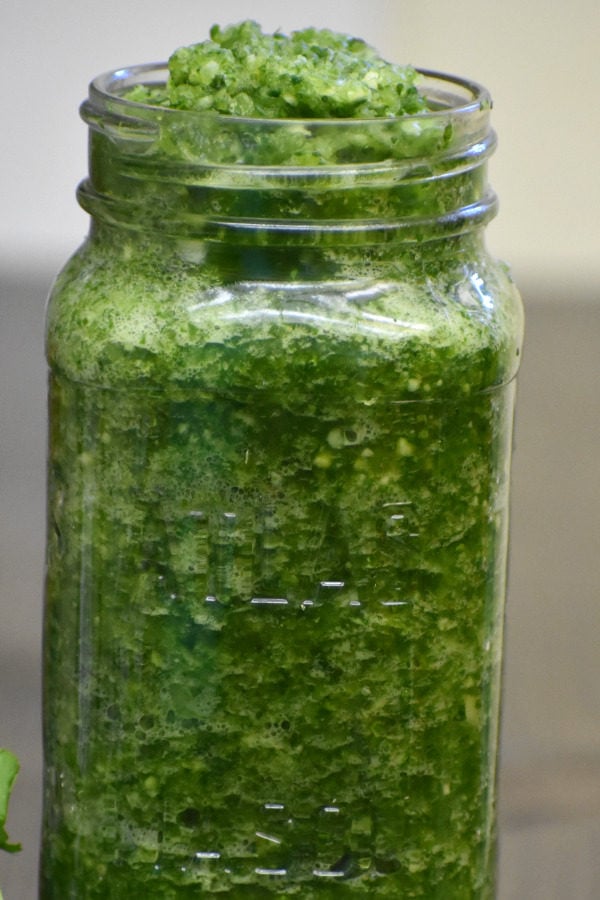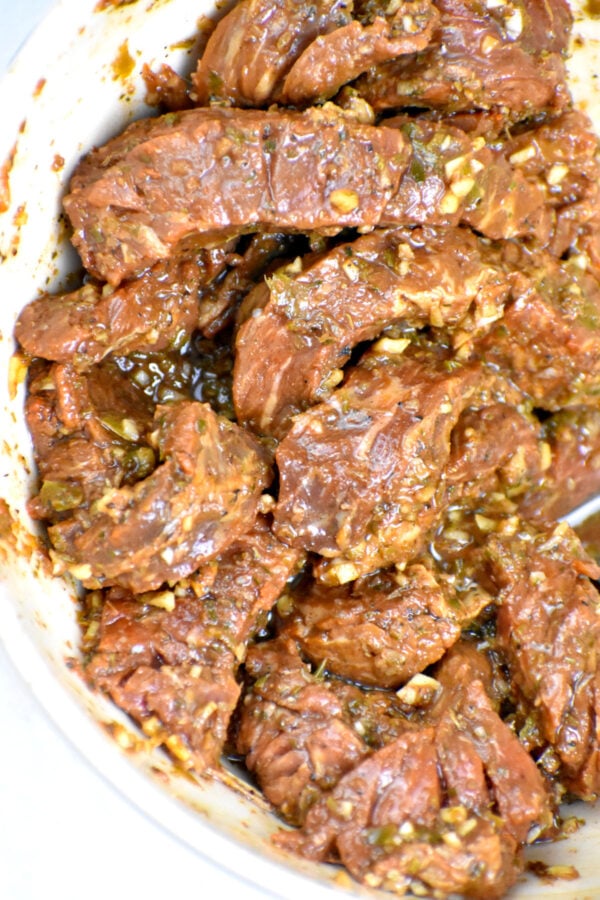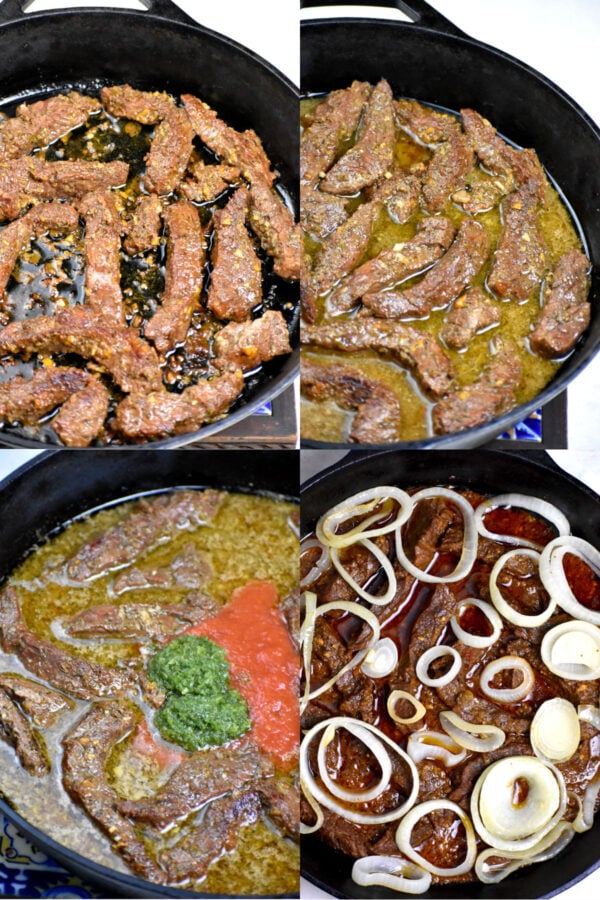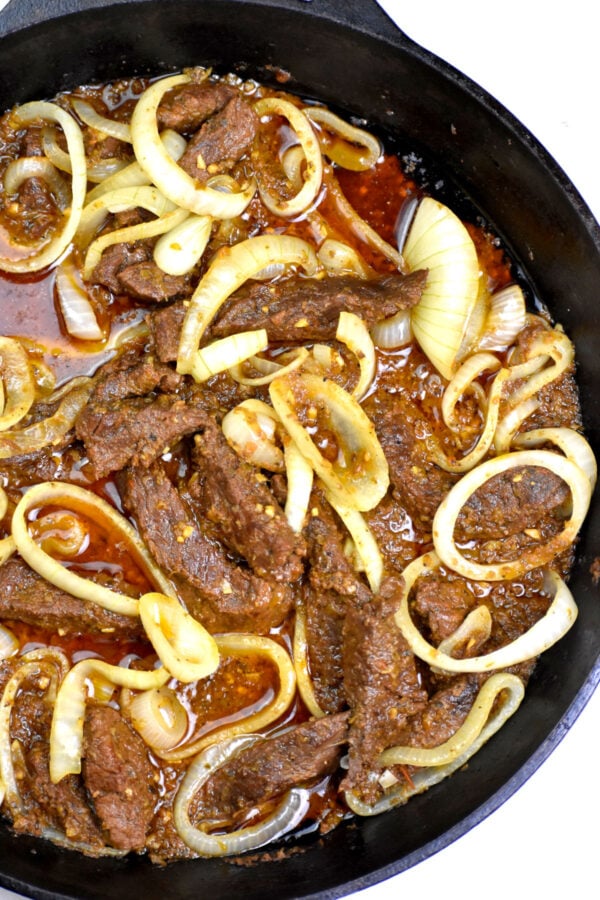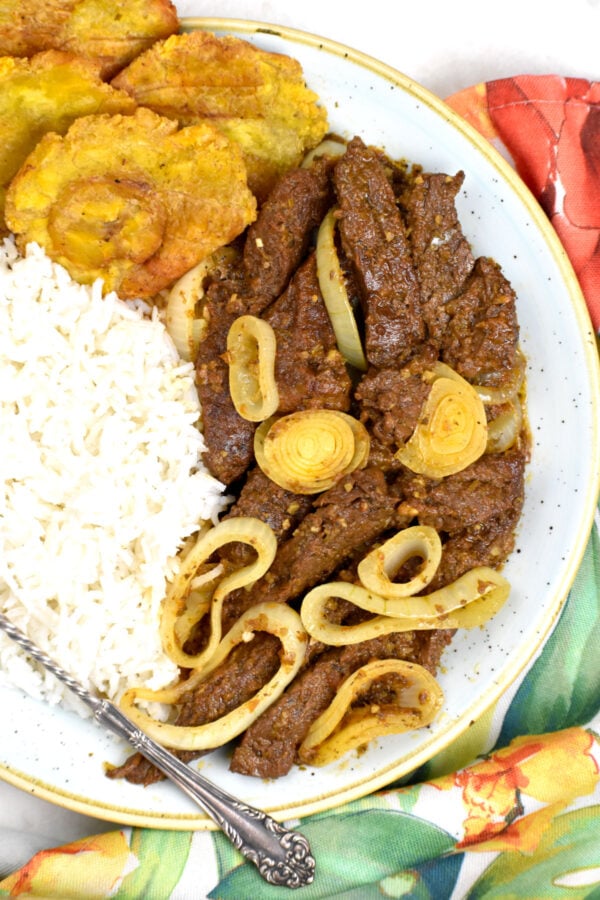This is what a typical Puerto Rican or Cuban momma cooks regularly. Why? It’s easy, it’s quick and it’s delicious in its simplicity. Bistec Encebollado, simply meaning Steak and Onions in Spanish. If you don’t know Bistec Encebollado… well, it’s about time you learn. 🙂
Spanish Cuisine in Caribbean Countries
Spanish food is very complex in flavor. It’s not hot or spicy, but always well seasoned and full bodied with the generous use of spices and herbs. Spanish speaking Caribbean countries like Puerto Rico, Cuba, Dominican Republic and many others have their roots in Spain, along with influences that can be traced to African slaves and natives of the region. Food can be a little different from island to island, and one key difference is the mix and proportions of the herbs and spices used in their stews or curries. Cubans are partial to cumin, Dominicans to oregano, and Puerto Ricans can’t imagine cooking anything without their beloved cilantro and culantro. The main essence of their cuisine is sofrito, which is nothing but a blend of a few herbs along with garlic, onion and some chili peppers. This mix forms the foundation of many dishes. Some islands have cooked sofritos and some make uncooked or raw. GypsyPlate has a great Puerto Rican style Sofrito. The other defining seasoning is adobo, which is a blend of salt and spices. Both of these Latin staples are very easily available in the Latin section of your grocery store, as can Sazon, which also goes in this recipe.
What is Bistec Encebollado?
The word bistec probably came into existence when Spanish speakers tried to say the English phrase “beef steak”. Bistec, when you abbreviate. Encebollado means “cooked with onions”. So put together it’s beef steak cooked with onions… simple. Steak with onions is something that generations grew up on in many different countries and cultures. Everyone might have their own preferred go to recipe, and it can be called different names from country to country. They might call this Bistec Ranchero in Mexico, Bistec de Palomilla in Cuba, Bistec a lo Pobre in Peru, or Bistek Tagalog in the Philippines… Yes, they do have a Filipino version of this steak that comes with a pile of onions. In most cases the piece of steak is marinated for quite a while with herbs and spices, olive oil, vinegar and lots of garlic. Vinegar not only helps tenderize the meat, but also imparts unbelievably delicious flavors. Here is my Puerto Rican style version of this classic comfort dish. You would need some latin staples, but in a pinch can try it without… though I couldn’t guarantee those unmistakable latin flavors.
What Cut of Meat to Use
I personally think any steak would be great when you smother it with the amazing gravy. But traditionally they use any thin cuts of steak like skirt, cube, flank or sirloin. I am using flank today. Something that needs to be either quick cooked in a stir fry or simmered for a long time to get the same tender melt in your mouth effect. Steaks can be such an unforgiving piece of meat and need some TLC, unless you want to eat a dried out rubbery mess. In this case, it’s a little easier, as it will be simmered into smooth submission for some time.
About Sofrito
As I mentioned above, this is one of their key ingredients. It’s basically a quick blend of cilantro + culantro (optional) + onion + garlic + green peppers. You can check my Sofrito post for more details. I understand making it is an extra step, but you can make a large batch and freeze it. In a pinch, you can buy it from the Latin aisle in your grocery store. You can altogether skip it, but your Bistec might miss that Latin punch. It can still turn up good if you increase the garlic and add chopped cilantro and onions to the marinade.
Ingredients Needed
Steak Sofrito Goya sazon seasoning – Particularly Goya con culantro y achiote packet. Adobo – It’s Latin seasoning salt. In its absence you can use regular salt. Spices and herbs – Cumin, oregano, black pepper. Garlic Vinegar – Any vinegar is fine, I am using white vinegar. Tomato sauce or crushed tomatoes Onion Olive oil
How to Make Bistec Encebellado
- Marinate: I like to start by marinating the steak, and the longer it sits, the better. I recommend marinating it for at least 4-5 hours, or even from the morning if I’m planning to cook it for dinner. Some folks use whole steaks, but I usually cut them into strips before marinating to really let the flavors soak in. I just mix together some olive oil, vinegar, adobo, sazon, oregano, cumin, pepper, garlic, and sofrito. Then, I put the beef in this mixture and let it marinate in the refrigerator. It’s a simple step that makes a big difference in the flavor.
- Sear: When it’s time to cook, I give the steak a quick sear on both sides to get a nice brown color. This adds a delicious crust to the meat and locks in all those marinated flavors.
- Simmer: After searing the steak, I add the rest of the marinade to the pan along with a bit of water and start cooking it, covered. After about five minutes, I stir in some more sofrito and some tomato sauce, then keep cooking it covered until the steak is melt-in-your-mouth tender. Easy?
- Oh… Don’t forget the onions :). You can just add sliced or rings of onions over the steak in the last few minutes of cook time. I feel already caramelized onions add more flavor to the dish, so sauté them in a bit of butter and olive oil before adding over the steak. There you go. Unbelievable tasting steak with onions.
Serving Suggestions
It is perfect with any kind of rice, be it over a pile of white rice, yellow rice or their Arroz con gandules. Stacks of tostones… check out our tostones post… or mudoros, their sweet plantains. It goes great with some kind of beans, like Habichuelas Guisadas or Frijoles Negros, or some avocado. Or you can have a piece of bread to sop up the gravy, but we skipped it to give more attention to Bistec. Ahmm… good decision!
Some Variations
Alpana’s Tips
Marination Time: I make sure not to rush the marination process. The longer the steak marinates, the deeper the flavors will penetrate. Marinating it overnight is really the best way to go for the most flavorful result. Sofrito From Scratch: If I have the time, I always try to make homemade sofrito. Using fresh herbs and spices really amps up the flavors and makes a huge difference in the dish. It’s totally worth the extra effort! Proper Cookware: I use a heavy-bottomed skillet or Dutch oven when cooking the steak because it helps with even heat distribution. This ensures the steak cooks uniformly, which really helps in making it tender and delicious. Taste Test: Always taste the sauce midway through cooking.
We personally fell in love with Puerto Rican food after our introduction to Picadillo, one of our most popular recipes on GypsyPlate. That led us to explore more of what’s out there. Go through all the great Puerto Rican Food we’ve cooked for you over the years, and see why we like it so much. I love sharing with you what we are discovering. Sharing is caring, right? Share GypsyPlate, subscribe to GypsyPlate and spread the love… love for good food. Thank you for making our mailing list increase as the days go by. I hope you make this amazing recipe and let us know when you share this with your loved ones. Take care…
Bistec Encebollado, on our Gypsy Plate… With onions removed for my onionphobic husband!
Try these other great Latin beef recipes!Beef BirriaCaldo de ResCarne GuisadaLomo SaltadoCarne MechadaVaca FritaCarne PicadaSancocho For more tropical flavors, check out my collection of the 40 best Caribbean Recipes!
